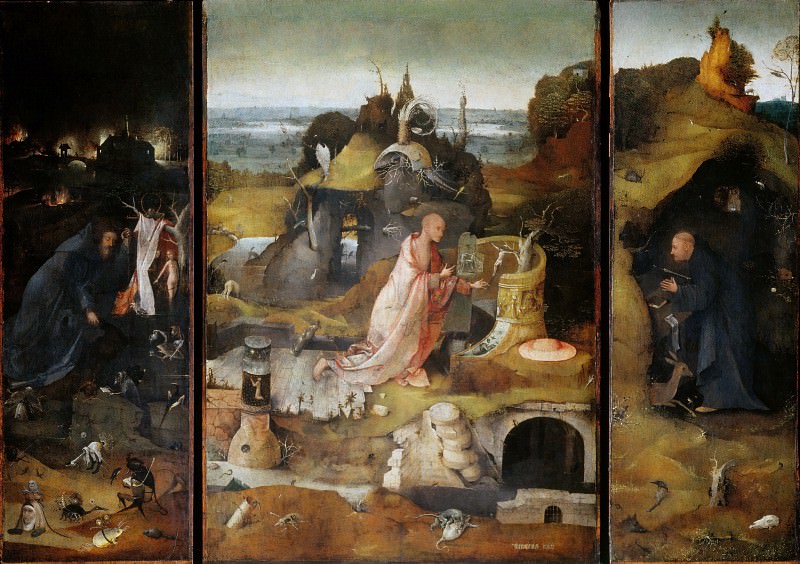Hermit Saints Triptych Hieronymus Bosch (1450-1516)
Hieronymus Bosch – Hermit Saints Triptych
Edit attribution
Download full size: 6156×4337 px (9,4 Mb)
Painter: Hieronymus Bosch
Location: Doge’s Palace, Venice (Palazzo Ducale).
Hieronymus Bosch painted most of his works on the subject of the lives of the saints, often using biblical subjects. The artist did not use sketches so popular in his day. Often depicting the creation of a miracle or an agonizing death, such paintings delighted people of the Middle Ages. Bosch was attracted to quiet subject lines that displayed spirituality and deep philosophical meaning. The "Holy Hermits" painting depicts hermits giving themselves over to their thoughts against the backdrop of nature.
Description of Hieronymus Bosch’s The Holy Hermits
Hieronymus Bosch painted most of his works on the subject of the lives of the saints, often using biblical subjects. The artist did not use sketches so popular in his day. Often depicting the creation of a miracle or an agonizing death, such paintings delighted people of the Middle Ages. Bosch was attracted to quiet subject lines that displayed spirituality and deep philosophical meaning.
The "Holy Hermits" painting depicts hermits giving themselves over to their thoughts against the backdrop of nature. All of the paintings show the principles of living in the tract "Imitation of Christ." The three subjects are very complex with many details. There is both humility and the seduction of female flesh. Holiness and sinful thoughts are intertwined, and, as we know, it is already sinful to think about sin.
The painting was created after reading The Book of Higher Truth. This mystical work influenced the artist’s worldview and served as inspiration for creating a pictorial masterpiece. The canvas depicts degrees of coming to a higher truth. In the central image, St. Jerome looks at the crucifixion of Christ as he seeks salvation in it. Around him are remnants of paganism and mental confrontations, depicted as two clutching monsters.
The artist portrayed him in an unconventional way, moving away from the image of the elder. The saint prays at the remnants of paganism, which have not yet disappeared. The left side displays the image of St. Anthony. He is tempted by a naked woman, with demons around her. This image of temptation very accurately conveys the carnal desires of the common man.
For the artist it was this saint who was closest. St. Anthony spent a lot of time in the desert. He resists temptation, and the glow of the burning village illuminates the companions of sin more and more vividly.
The right side of the work depicts the life of St. Aegius. He is comfortably seated in a cave and praying. A saint with an arrow sticking out of his chest. Such an image was traditional, he covered himself with a beloved deer. Saint Aegius guards all the poor and the poor. It is with his help that sins are absolved.
Кому понравилось
Пожалуйста, подождите
На эту операцию может потребоваться несколько секунд.
Информация появится в новом окне,
если открытие новых окон не запрещено в настройках вашего браузера.
You need to login
Для работы с коллекциями – пожалуйста, войдите в аккаунт (open in new window).




















You cannot comment Why?
The Hermit Saints Triptych by Hieronymus Bosch is a three-part altarpiece that depicts scenes from the lives of saints and the temptations they face.
Left Panel: This panel is dominated by darkness and chaos, symbolizing temptation and sin. A monk in a blue robe is depicted in the foreground, possibly tempted by a vision of Christ on the cross, or about to be tormented by demonic figures. The background is ablaze with fires and buildings, suggesting destruction and damnation. Small, grotesque creatures and figures are scattered throughout the scene, intensifying the sense of spiritual struggle and peril.
Center Panel: This central panel focuses on a kneeling, bald figure, likely a hermit saint, in a pink robe. The saint appears to be in contemplation or prayer, looking towards a golden goblet and a barren tree. The landscape is surreal and deserted, with strange architectural elements and geological formations. Small animals, including rats and birds, inhabit this desolate environment, hinting at the natural worlds presence even in isolation. The overall mood is one of quiet introspection and spiritual endurance amidst a bizarre and possibly hallucinatory setting.
Right Panel: This panel depicts another hermit saint, this time in a dark blue robe, kneeling in a cavernous landscape. He is shown with a book and a deer, which symbolizes purity and spiritual longing in religious art. The scene is darker and more enclosed than the center panel, suggesting a secluded place of prayer and meditation. The background features sparse vegetation and rocky outcrops. Small creatures are again present, but the overall impression is one of solitary devotion and the saints steadfastness against unseen or implied temptations.
Subtexts:
The triptych explores the theme of spiritual struggle, temptation, and salvation. Each panel presents a different aspect of the hermits life: the intense battles against external and internal demons (left), the solitary contemplation and the allure of the material world (center), and the quiet devotion and perseverance in faith (right).
Boschs characteristic surrealism and symbolism are evident throughout. The grotesque figures in the left panel represent sin and the devils machinations. The strange, desolate landscapes can be interpreted as the internal spiritual landscapes of the saints, or the world from which they have withdrawn. The animals and vegetation may symbolize aspects of nature, temptation, or the divine presence within the natural world.
The triptych likely serves as a meditation on faith and the challenges of Christian living, offering viewers a visual admonition against sin and a testament to the power of devotion and righteousness. The contrast between the chaotic and fiery imagery of temptation and the serene, albeit bizarre, isolation of the saints underscores the difficult path to spiritual enlightenment.